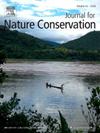Nestedness in a fish-parasite ecological network in the Gulf of California: a potential buffer against extinction
IF 2.2
3区 环境科学与生态学
Q2 BIODIVERSITY CONSERVATION
引用次数: 0
Abstract
Marine biodiversity is declining due to overfishing, pushing many species to the brink of extinction and profoundly affecting fish–parasite networks. However, the impact of coextinctions of core species within these networks remains unexplored. In this study, we analyzed the effects of coextinctions on a network comprising 10 carangid fish species and 39 metazoan parasite species in the southeastern Gulf of California. Four scenarios were simulated: the removal of a fish species vulnerable to extinction, the removal of all core fish species, the removal of core parasite species, and the removal of both core fish and parasite species. Core species were identified based on network centrality, and network structure was assessed using metrics of nestedness, modularity, robustness, and connectance. Nestedness and modularity were calculated using NODF and MODULAR software, respectively, while robustness and connectance were computed with the “bipartite” package in R. The network’s core consisted of two fish species and five parasite species; their removal triggered a reorganization that shifted peripheral species into core roles. In all scenarios, the network was nested and robust, with low modularity and connectance. Most post-extinction metrics were significantly lower than those from null models, and the highest coextinction rate occurred when species were removed from most to least connected. Recognizing parasites as essential components of ecosystems may contribute to more inclusive and effective conservation strategies, integrating their protection into fisheries management and marine conservation policies.
加利福尼亚湾鱼类-寄生虫生态网络中的筑巢:防止灭绝的潜在缓冲
由于过度捕捞,海洋生物多样性正在下降,将许多物种推向灭绝的边缘,并深刻影响了鱼类-寄生虫网络。然而,这些网络中核心物种共同灭绝的影响仍未被探索。在这项研究中,我们分析了共同灭绝对加利福尼亚湾东南部一个由10种carangid鱼类和39种后生动物寄生虫组成的网络的影响。模拟了四种情景:一种濒临灭绝的鱼类被清除、所有核心鱼类被清除、核心寄生物种被清除、核心鱼类和寄生物种都被清除。基于网络中心性确定核心物种,并使用巢性、模块化、鲁棒性和连通性等指标评估网络结构。利用NODF和MODULAR软件分别计算网络的巢性和模块化,利用r中的“bipartite”软件包计算网络的鲁棒性和连通性。它们的移除引发了将边缘物种转变为核心角色的重组。在所有场景下,网络都是嵌套的、鲁棒的,模块化和连通性都很低。大多数灭绝后指标显著低于零模型,当物种从联系最密切到联系最不密切时,共灭绝率最高。认识到寄生虫是生态系统的重要组成部分,可能有助于制定更具包容性和更有效的养护战略,将对它们的保护纳入渔业管理和海洋养护政策。
本文章由计算机程序翻译,如有差异,请以英文原文为准。
求助全文
约1分钟内获得全文
求助全文
来源期刊

Journal for Nature Conservation
环境科学-生态学
CiteScore
3.70
自引率
5.00%
发文量
151
审稿时长
7.9 weeks
期刊介绍:
The Journal for Nature Conservation addresses concepts, methods and techniques for nature conservation. This international and interdisciplinary journal encourages collaboration between scientists and practitioners, including the integration of biodiversity issues with social and economic concepts. Therefore, conceptual, technical and methodological papers, as well as reviews, research papers, and short communications are welcomed from a wide range of disciplines, including theoretical ecology, landscape ecology, restoration ecology, ecological modelling, and others, provided that there is a clear connection and immediate relevance to nature conservation.
Manuscripts without any immediate conservation context, such as inventories, distribution modelling, genetic studies, animal behaviour, plant physiology, will not be considered for this journal; though such data may be useful for conservationists and managers in the future, this is outside of the current scope of the journal.
 求助内容:
求助内容: 应助结果提醒方式:
应助结果提醒方式:


